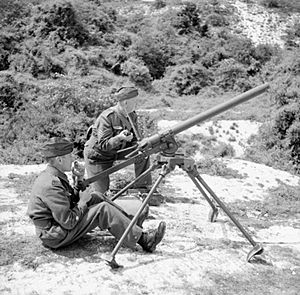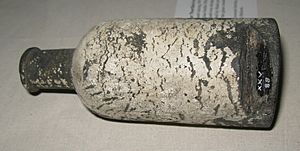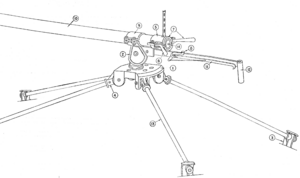Northover Projector facts for kids
Quick facts for kids Northover Projector |
|
|---|---|

Members of the Home Guard using a Northover Projector, 1 July 1941.
|
|
| Type | Grenade launcher |
| Place of origin | United Kingdom |
| Service history | |
| In service | 1940–1945 |
| Used by | British Army, Home Guard |
| Wars | Second World War |
| Production history | |
| Designer | Major Robert Harry Northover |
| Designed | 1940 |
| Unit cost | £10 (1940) |
| Variants | Northover Mk 2 |
| Specifications | |
| Mass | 27.2 kilograms |
| Barrel length | 914 mm (36.0 in) |
|
|
|
| Calibre | 2.5 inch |
| Elevation | free |
| Traverse | free |
| Muzzle velocity | 60m/sec (200ft/sec) |
| Effective firing range | 251 m (274 yd) |
The Northover Projector was a special weapon used by the British Army and the Home Guard during Second World War. Its official name was the "Projector, 2.5 inch." It was created quickly to help defend Britain when a German invasion seemed possible.
This weapon was designed by a Home Guard officer named Robert Harry Northover. It was put into production in 1940. This happened after a demonstration for the Prime Minister, Winston Churchill, who approved it.
The Northover Projector was a simple metal tube on a tripod. It fired rounds using black powder. It could hit targets up to 100 to 150 yards away. It was cheap and easy to make. However, it was hard to move. Also, the special grenades it used sometimes broke inside the weapon. This could damage the projector and hurt the people using it. By early 1943, almost 19,000 of these weapons were in use. Later, better weapons like the 2-pounder anti-tank gun replaced it.
Contents
Why Was the Northover Projector Needed?
After the Battle of France and the Dunkirk evacuation in 1940, Britain faced a big threat. A German invasion, called Operation Sealion, seemed very likely. The British Army was not ready to defend the country. Many of their anti-tank guns were left behind in France. Only a few were left in Britain. There was also very little ammunition. Soldiers were not even allowed to use a single bullet for practice.
Because of this shortage, all modern weapons went to the regular army. The Home Guard, a volunteer defense force, had to use older or makeshift weapons. The Northover Projector was one of these.
How Was the Projector Developed?
Major Robert Harry Northover, a Home Guard officer, invented the weapon. He wanted to create a cheap and easy-to-make anti-tank weapon. It cost less than £10 to produce, not including the tripod.
Major Northover wrote directly to Prime Minister Winston Churchill about his idea. He arranged a demonstration for Churchill. The Prime Minister liked the weapon and personally supported it. In October 1940, he ordered that many Northover Projectors be made. The goal was to have one for every Home Guard platoon.
What Was the Northover Projector Like?
The Northover Projector was officially called the "Projector, 2.5 inch." It looked like a hollow metal tube, similar to a drain pipe. This tube was placed on a cast-iron tripod. The whole weapon weighed about 27.2 kilograms (about 60 pounds).
It had a simple firing part at one end. Rounds were fired using a small amount of black powder. This powder was lit by a special copper cap, like those used in old rifles. The tripod legs helped absorb the kickback when it fired.
What Ammunition Did It Use?
The weapon could fire different types of ammunition. One type was the No. 76 Special Incendiary Grenade. This was a glass bottle filled with a special mixture. When it broke, it burst into bright flames and made a lot of smoke. It could also fire regular hand grenades and rifle grenades.
The Northover Projector had a maximum range of about 300 yards. However, it was only accurate when shooting between 100 and 150 yards. Home Guard units sometimes changed the weapon. They would mount it on carriages or even on the sidecars of motorcycles. It usually needed a team of three people to operate it.
What Were Its Problems?
The Projector had several issues. It was heavy and hard to move around. If the tripod was dropped, it could easily get damaged. The force it fired with was not very strong.
The special phosphorus grenades also caused problems. If too much black powder was used, they could explode inside the weapon. If too little was used, they might fall short. Sometimes, they didn't explode at all. They could also break inside the barrel when fired. This often damaged the weapon and injured the crew.
Even when fired correctly, the Projector created a large cloud of smoke. This smoke could take up to a minute to clear. It also showed the enemy exactly where the weapon was located. Some experts doubted how effective it would be against tanks, especially with hand and rifle grenades.
To make it easier to handle, a lighter version was made in 1941. This was called the Northover Projector Mk 2. However, not many of these were produced.
How Was the Northover Projector Used?
The Northover Projector was given to both the Home Guard and regular British Army units. By August 1941, over 8,000 of these projectors were in use. This number grew to 18,919 by early 1943.
People had different opinions about the Northover Projector at first. Some Home Guard volunteers were unsure about its unusual design. Some officers never believed it would be truly useful. However, most Home Guard units eventually accepted the weapon. They gained confidence in it. This was helped by a lot of "War Office propaganda" that highlighted its good points. These included how simple it was to use, how easy to make, and how little maintenance it needed. One Home Guard volunteer said it was "something to be accepted gratefully until something better arrived."
Like many older weapons made for the Home Guard, the Northover Projector was only taken out of service when better weapons became available. These included weapons like the 2-pounder anti-tank gun.
See also
- Ampulomet — a similar Soviet weapon from World War II
- Smith gun
- Blacker Bombard




